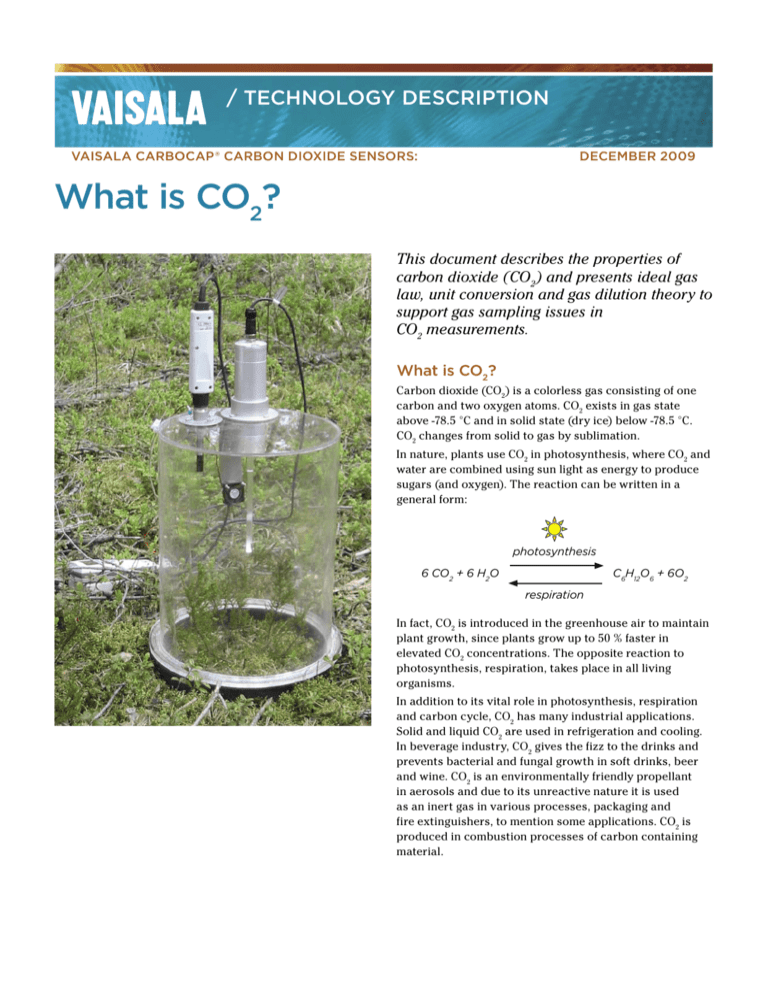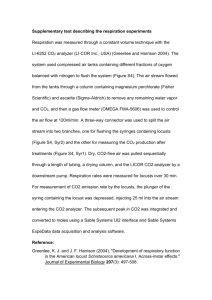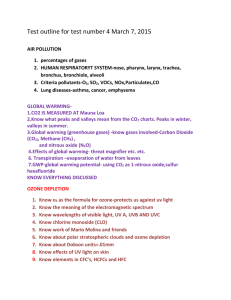
/ TECHNOLOGYVaisala
DESCRIPTION
CARBOCAP® Carbon
Dioxide Sensors:
Vaisala CARBOCAP® Carbon Dioxide Sensors:
This document describes the properties of
carbon dioxide (CO2) and presents ideal gas
law,
conversion
and gas
theory
Thisunit
document
describes
thedilution
properties
of
tocarbon
support
gas
sampling
issues
in
CO
dioxide (CO2) and presents 2ideal gas
law, unit conversion and gas dilution theory to
measurements.
support gas sampling issues in
CO2 measurements.
What
is CO2?
Carbon
(CO
Whatdioxide
is CO
?2) is a colorless gas consisting of one
2
carbon
and
two
oxygen
atoms.
CO2 exists
in gas stateof one
Carbon dioxide (CO2) is
a colorless
gas consisting
above
-78.5°C
andoxygen
in solidatoms.
state (dry
below
-78.5°C.
carbon
and two
CO2 ice)
exists
in gas
state
above
-78.5
°C
and
in
solid
state
(dry
ice)
below
-78.5
°C.
CO
changes
from
solid
to
gas
by
sublimation.
2
CO2 changes from solid to gas by sublimation.
nature,plants
plants
use
CO
in photosynthesis, where CO and
InInnature,
use
CO
2 photosynthesis, where CO2 2
2 in
water
are
combined
using
sun
light
asas
energy
and water are combined using
sun
light
energytotoproduce
sugars (and oxygen). The reaction can be written in a
produce sugars (and oxygen). The reaction can be written
general form:
in a general form:
photosynthesis
6 CO2 + 6 H2O C
H O + 6O2
6 12 6
respiration
In fact, CO2 is introduced in the greenhouse air to maintain
In fact,
CO2 issince
introduced
in theupgreenhouse
airin
to maintain
plant
growth,
plants grow
to 50% faster
plant
growth,
since
plants
grow
up
to
50
%
faster
elevated CO2 concentrations. The opposite reaction in
to
elevated CO2 concentrations. The opposite reaction to
photosynthesis,
respiration, takes place in all living
photosynthesis, respiration, takes place in all living
organisms.
organisms.
Typi
CO2
doesn
conc
conc
Table
Con
350
600
100
500
600
3-8%
abo
abo
To en
poten
insta
possi
pools
trans
asses
Phy
CO2
This
conc
this a
CO2
100
In addition to its vital role in photosynthesis, respiration
Inand
addition
tocycle,
its vital
inmany
photosynthesis,
carbon
COrole
has
industrial respiration
applications.
2
and
carbon
cycle, CO
CO2 2are
hasused
manyinindustrial
applications.
Solid
and liquid
refrigeration
and cooling.
In
beverage
industry,
CO
gives
the
fizz
to
the
and
Solid and liquid CO2 are used
in refrigeration anddrinks
cooling.
2
prevents
bacterial
and
fungal
growth
in
soft
drinks,
beer
In beverage industry, CO2 gives the fizz to the drinks and
and wine. CO2 is an environmentally friendly propellant
prevents bacterial
and fungal growth in soft drinks, beer
in aerosols and due to its unreactive nature it is used
and
wine.
CO
is
an
environmentally
propellant
2 in various
as an inert gas
processes,friendly
packaging
and in
aerosols
and due to its
nature
it is used asCO
an is
fire extinguishers,
to unreactive
mention some
applications.
2
inert
gas in in
various
processes,
packaging
and firecontaining
produced
combustion
processes
of carbon
material.
extinguishers,
to mention some applications. CO2 is
produced in combustion processes of carbon containing
material.
90
80
TRANSMISSION (%)
What is CO2?
What is CO2?
DECEMBER 2009
Effe
70
60
50
40
30
20
10
0
10
Figu
Effects of CO2
Typical atmospheric CO2
concentration is 350-450 ppm. CO2
is a non-toxic and non-flammable
gas. However, it doesn’t support
life and exposure to elevated CO2
concentrations can induce a risk to
life. The effects of CO2 concentrations
on people are summarized in Table 1.
To ensure the safety of the people
in facilities having a potential risk
for CO2 leakage, CO2 transmitters
should be installed as close to the
potential leakage points as possible.
CO2 is heavier than air, therefore it
sinks and pools low to the ground,
displacing the oxygen. The CO2
transmitter installations should
always be based on risk assessment.
Table 1. Effect of CO2 concentrations on people.
Concentration 350-450 ppm 600-800 ppm
1000 ppm
5000 ppm 600-30 000 ppm 3-8% above 10% above 20% Effect
Typical atmospheric
Acceptable indoor air quality
Tolerable indoor air quality
Average exposure limit over 8 hours
Concern, short exposure only
Increased respiration and headache
Nausea, vomiting, unconsciousness
Rapid unconsciousness, death
Physical properties of CO2
CO2 absorbs light in the infrared (IR)
region, see Figure 1. This absorption
can be utilized to measure
volumetric concentration of CO2.
Vaisala CARBOCAP® is utilizing this
absorption in the silicon-based nondispersive infrared CO2 sensors.
This IR absorption of CO2 is partly
responsible for the greenhouse
effect. The greenhouse effect
is a property of any planetary
atmosphere, which results in the
temperature of the planet surface
being higher than without the
atmosphere. Any gas absorbing sun
light causes greenhouse effect, the
most important greenhouse gases on
planet earth being water vapor, CO2
and methane, all absorbing in the IR
region.
Some physical properties of CO2 are
collected to Table 2.
Ideal gas law
Ideal gas law is an equation
describing the state of a hypothetical
ideal gas. The ideal gas law relates
the state of a certain amount of
gas to its pressure, volume, and
temperature according to the
equation:
Figure 1. IR absorption of some gases.
Table 2. Physical properties of CO2.
CO2 Physical Properties
Molecular weight Gas density (1013 bar, 15°C)
Solid density
Specific gravity (air = 1) (1.013 bar, 21 °C) Volume of 1 kg of dry ice in gas phase Critical temperature and pressure
Triple point temperature and pressure Sublimation point 44.01 g/mol
1.87 kg/m3
1562 kg/m3
1.521
0.518 m3
31 °C, 73.825 bar
-56.6 °C, 5.185 bar
-78.5 °C
where
p = pressure [Pa]
V = volume of the gas [m3]
n = amount of gas [mol]
R =universal gas constant
(= 8.3145 J/mol K)
T = temperature [K]
Ideal gas is a hypothetical gas having
zero volume identical particles with
no intermolecular forces. The ideal
gas atoms or molecules are assumed
to undergo elastic collisions with the
container walls. In reality, gases do
not behave exactly like ideal gases,
but this approximation is often good
enough to describe real gases.
Most gas sensors give out a signal
proportional to the molecular
density (molecules/cm3), even
though the reading is expressed
in ppm units. Changing p and/or T
changes the molecular density of
the gas according to the ideal gas
law. This is seen in the sensor ppm
reading. In exact terms this is an
error in the measurement, since the
concentration of the gas (in ppm
units) doesn’t change with varying
temperature and pressure.
Table 3. Reading of a 1 000 ppm concentration (SATP) in different
temperature and pressure conditions.
­
700
pressure (hPa)
pV= nRT
Temperature (°C)
-20
-10
0
10
20
25
30
40
50
60
814
783
754
728
703
691
680
658
638
618
800
930
895
862
832
803
790
777
752
729
707
900
1046
1007
970
936
904
888
874
846
820
795
1000
1163
1119
1078
1039
1004
987
971
940
911
883
1013
1178
1133
1092
1053
1017
1000
983
952
923
895
1100
1279
1230
1185
1143
1104
1086
1068
1034
1002
972
1200
1395
1342
1293
1247
1205
1185
1165
1128
1093
1060
1300
1512
1454
1401
1351
1305
1283
1262
1222
1184
1148
This density formula can be used to
calculate how the gas sensor reading
changes as a function of t and p.
The data can also be used to correct
the gas sensor reading for t and p
variations.
Table 3 shows how the reading of a
1 000 ppm (at SATP) concentration
changes with t and p according to
ideal gas law.
Table 4. Unit conversion tables for pressure, temperature, length
and flow rate.
The ideal gas law can be used to
calculate the (molecular) density of a
gas at given t and p, when the density
at Standard Ambient Temperature
and Pressure (SATP) conditions is
known. Replacing n by (pV/M) and
assuming molar mass M constant
in the two different conditions the
equation can be written as:
p
298
p(t, p) = p(25 °C, 1013hPa) x
x
1013(273 + t)
Pressure
To
From
bar
bar
psi
torr
kPa
1
14.5
750
100
0.987
psi
0.0690
1
51.7
689
0.0680
torr
0.00133
0.0193
1
0.1330
0.00132
kPa
0.0100
0.0015
7.5188
1
0.00987
Temperature
K (Kelvin)
°C + 273.15
F (Fahrenheit)
(°C + 17.78) x 1.8
C (Celsius)
0.56 x °F - 17.78
Flow rate
l/m
scfh
scfm
l/min
1
2.2
0.0353
scfh
0.472
1
0.0167
scfm
28.3
60
1
where
p =gas volume concentration
[ppm or %]
atm
Length
m
ft
in
p =ambient pressure [hPa]
m
1
3.28
39.4
t = ambient temperature [°C]
ft
0.305
1
12
in
0.0254
0.0833
1
Unit conversions
The dilution effect of water can
be estimated using Table 5, which
contains the dilution coefficients for
gas concentrations when drying a
gas sample. Dewpoint (Td, at 1013
hPa) or the H2O concentration of
the wet sample is chosen from the
horizontal axis and the dewpoint or
H2O concentration of the dried sample
on vertical axis.
of a gas mixture is varied in constant
p, T and V. All the molecules in a gas
mixture occupy the same system
volume (V is the same for all gases)
and they exist in the same T. The
ideal gas law can be modified to:
CO2 concentration in the air is
350-450 ppm. The ppm unit is an
abbreviation from parts per million,
thus 1 ppm means one part in 1x106.
Thus 1 % = 10 000 ppm.
The following tables can be used to
convert pressure, temperature, flow
rate and length units from SI units to
other units and vice versa. To make
a unit conversion in pressure, length
and flow rate, select the known unit
from the left column and multiply by
the number in the corresponding cell
for unit conversion. For temperature
conversions, the formulas are given
in Table 4.
Drying a wet gas sample
Processing the ideal gas law a bit
further provides a way to understand
what happens when the composition
RT
p = (ngas1 + ngas2 + ngas3 +... ngasn) x
V
p = pgas1 + pgas2 + pgas3 +... pgasn
Here is an example how to use Table 5:
A gas sample is drawn from 40 °C(Td)
to 20°C(Td) environment. The
measured gas concentration of
5.263 % at 20 °C(Td) means 5.00 % in
the 40 °C(Td) environment (5.263 % x
0.950 = 5.00 %). This lower reading is
caused by the dilution due to higher
water content in 40 °C(Td).
The lower equation is called Dalton’s
Law of Partial Pressure. It states that
the pressure of a gas mixture is the
sum of the partial pressures of the
components in the mixture.
This information is useful when
taking account the influence of water
vapor on CO2 sensor reading. For
example, if water vapor is added
to a dry gas in constant p, T and V,
water replaces some of the other gas
molecules in the mixture.
Table 5. Dilution coefficients for drying a wet gas sample.
Td (°C)
-40
-30
-20
-10
0
10
20
30
40
50
60
Td (°C)
ppm H2O
127
377
1020
2580
6060
12200
23200
42000
73000
122000
19700
-60
11
0.9999
0.9996
0.999
0.997
0.994
0.988
0.977
0.958
0.927
0.878
0.803
-50
39
0.9999
0.9997
0.999
0.997
0.994
0.988
0.977
0.958
0.927
0.878
0.803
-40
127
1.0000
0.9997
0.999
0.998
0.994
0.988
0.977
0.958
0.927
0.878
0.803
1.0000
0.999
0.998
0.994
0.988
0.977
0.958
0.927
0.878
0.803
1.000
0.998
0.995
0.989
0.978
0.959
0.928
0.879
0.804
1.000
0.997
0.990
0.979
0.961
0.930
0.880
0.805
1.000
0.994
0.983
0.964
0.933
0.884
0.809
1.000
0.989
0.970
0.939
0.890
0.815
1.000
0.981
0.950
0.901
0.826
0.969
0.920
0.845
1.000
0.951
0.876
1.000
0.925
-30
377
-20
1020
-10
2580
0
6060
10
12200
20
23200
30
42000
40
73000
50
122000
60
197000
1.000
1.000
For more information, visit
www.vaisala.com or contact
us at aviationsales@vaisala.com
Ref. B210926EN-A ©Vaisala 2009
This material is subject to copyright protection, with all
copyrights retained by Vaisala and its individual partners. All
rights reserved. Any logos and/or product names are trademarks
of Vaisala or its individual partners. The reproduction, transfer,
distribution or storage of information contained in this brochure
in any form without the prior written consent of Vaisala is strictly
prohibited. All specifications — technical included — are subject
to change without notice.









